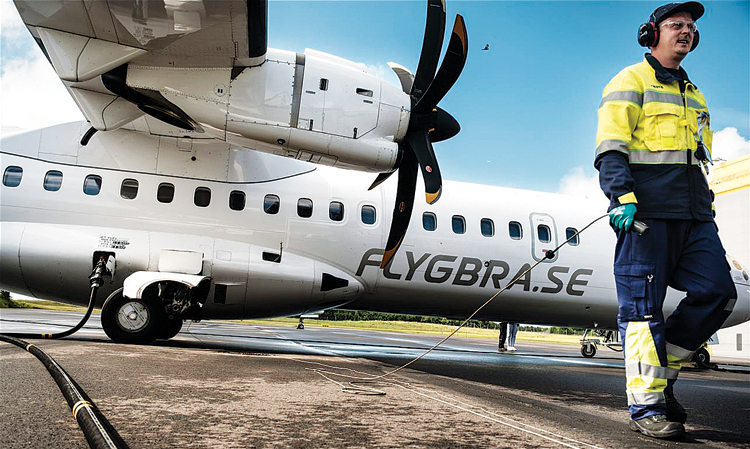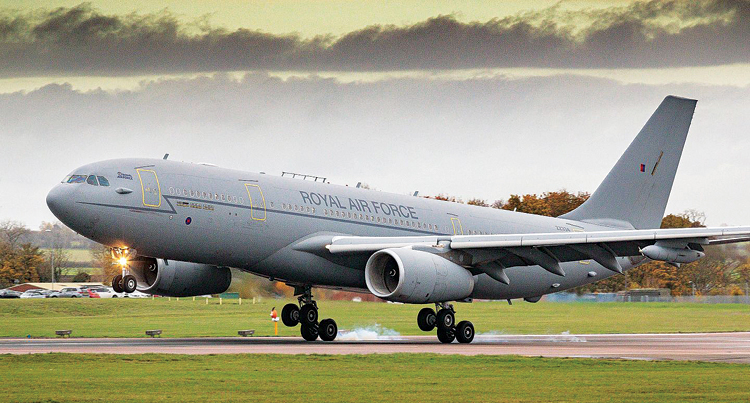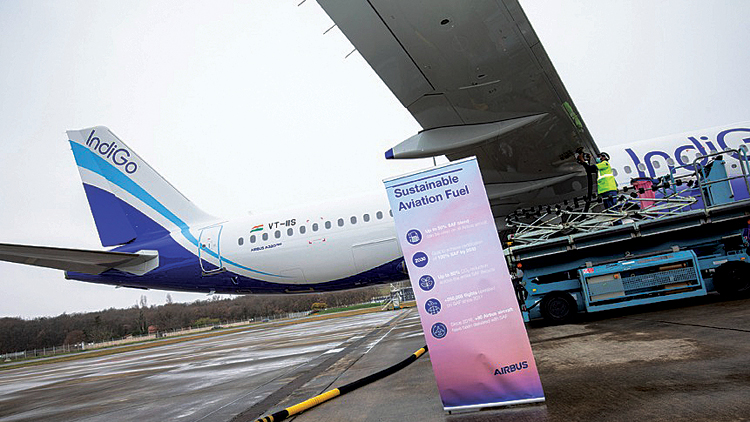INDIAN ARMED FORCES CHIEFS ON
OUR RELENTLESS AND FOCUSED PUBLISHING EFFORTS

SP Guide Publications puts forth a well compiled articulation of issues, pursuits and accomplishments of the Indian Army, over the years

I am confident that SP Guide Publications would continue to inform, inspire and influence.

My compliments to SP Guide Publications for informative and credible reportage on contemporary aerospace issues over the past six decades.
Solving the Net Zero Conundrum with SAF
The aviation industry realises that SAF is the most viable option to attain the very challenging target of net zero CO2 emissions by 2050 that has been set for it

With each passing day, the threat of irreversible climate change triggered by anthropogenic global warming draws nearer. And becomes scarier. Greenhouse gas (GHG) emissions due to humanity’s unbridled combustion of fossil fuels such as coal, oil, and natural gas are chiefly to blame. Climate change mitigation strategies now top the agenda of practically every sector of the economy, every decision making body and every forum.
Aviation can hardly be called a major emitter, accounting for just 2.4 per cent of global CO2 emissions. However, while other carbon-spewing industries like energy, road transport, and steel and cement manufacturing are progressively going green, air travel is incredibly difficult to decarbonise. Hence aviation’s relative share of emissions threatens to at least triple by 2050 as air traffic growth surges and other industries successfully decarbonise. At the 77th International Air Transport Association (IATA) Annual General Meeting in Boston in October 2021, a resolution was passed by member airlines committing them to achieving net zero carbon emissions from their operations by 2050. Just a year later, in October 2022, member states of the International Civil Aviation Organization (ICAO) also agreed to a long-term aspirational goal (LTAG) of net zero emissions from aviation by 2050. Net zero means the amount of GHG removed from the atmosphere is equal to that emitted by the human activity, in this case aviation.

The aviation industry has begun to put its shoulder to the wheel to achieve this very challenging target. For instance, the CFM International RISE (Revolutionary Innovation for Sustainable Engines) Technology Demonstration Program, launched in June 2021, aims to slash fuel consumption and carbon emissions by more than 20 per cent compared to today’s most efficient commercial jet engines, as well as ensure compatibility with alternative energy sources like Sustainable Aviation Fuels (SAF), electricity and hydrogen. However, just 13 per cent of the required CO2 abatement is expected from new aircraft technologies such as RISE, and 22 per cent from more efficient operations and infrastructure as well as credible offsetting schemes and direct carbon capture. The lion’s share of 65 per cent of the contribution to net zero is projected to come from SAF. While the actual shares of these options and the path to achieve them will vary depending on what measures are the most cost-effective at any particular time, IATA claims that SAF can potentially cut emissions by up to 80 per cent during its full lifecycle compared to conventional fossil fuel.
SAF SUPPORT SYSTEM
SAF, also known as biojet fuel, is specifically designed for use in aviation and aims to reduce GHG emissions and promote environmental sustainability. It is produced only from renewable sources such as biomass, agricultural waste, or non-fossil carbon feedstocks. Although SAF releases the same amount of CO2 as normal fuel, the benefit comes from the fuel manufacturing process which can absorb CO2 up to 100 per cent of that created when burned. SAF is normally “drop-in ready” and compatible with existing aircraft fleets. It requires no change or investment from airports, as existing equipment can be used, so no additional spending is required.

Industry support for SAF production and use is therefore growing:
- Investment and Research: Airlines, aircraft manufacturers and fuel producers are investing in R&D to improve SAF production technologies and explore alternative fuel sources.
- SAF Supply Chain: The aviation industry is helping to develop a robust and sustainable supply chain. This involves establishing partnerships with feedstock suppliers, fuel producers and distributors to ensure a reliable and consistent supply of SAF. Last year over 300 million litres of SAF were produced. However, this was less than one per cent of all jet fuel used worldwide. The reason for the poor utilisation of SAF despite its many advantages is cost. While the cheapest SAF derived from waste oils costs almost twice as much as regular fuel, the power-to-liquid variety can cost four or five times as much. As utilisation increases, the economies of scale factor would lower prices.
- Demonstrations and Trials: Airlines and aircraft manufacturers regularly conduct demonstrations and trials to showcase the viability and performance of SAF. These help build confidence in the use of SAF and encourage further adoption. The number of commercial flights operated using SAF has crossed 492,000 and will easily cross half a million this year.
- Commitments: Airlines and aviation organisations are making specific commitments to reduce their carbon emissions and increase the use of SAF. For instance, the World Economic Forum’s (WEF) Clean Skies for Tomorrow Coalition event in September 2021 saw over 60 companies pledge to work together to power global aviation with 10 per cent SAF by 2030.
SAF TAKES FLIGHT
- 492,000 commercial flights operated using SAF since 2011
- 6 airports regularly supplied with SAF
- 2% of fuel demand can be met by SAF by 2025
- 6 bn litres of SAF in Current forward purchase agreements by airlines
- 9 airlines have significant off-take agreements to purchase SAF
- 7 approved pathways for producing SAF
Source: Aviation: Benefits Beyond Borders - accessed May 2023
MILESTONES
Fifteen years have elapsed since the first cautious test flight of SAF involving a four-engine airliner. Here are a few major milestones on the SAF journey.
- In February 2008, Virgin Atlantic flight tested a Boeing 747 equipped with General Electric engines using a 20 per cent biofuel blend in one engine. No modifications were made to either aircraft or engines.
- In June 2011, KLM operated a Boeing 737-800 with 171 passengers from Amsterdam to Paris using a blend of waste vegetable oil. It was the world’s first commercial biofuel flight.
- In November 2021, Airbus conducted its first 100 per cent SAF test flight on the A350.
- In December 2021, United Airlines flew an aircraft full of passengers using 100 per cent SAF in one engine of a new Boeing 737 MAX 8 between Chicago and Washington. The other engine used conventional jet fuel to further prove that there are no operational differences between the two types of fuel. The use of SAF is key to United’s aim of achieving net zero by 2050. It claims to be the first airline to commit to net zero 2050 without relying on offsets.
- In November, 2022 a Royal Air Force Airbus A330 MRTT Voyager – the military variant of the Airbus A330 jetliner – flew on refined cooking oil using 100 per cent SAF in both engines. It was claimed to be “the world’s first 100 per cent SAF flight using an in-service military aircraft of its size.”
- In June 2022, regional aircraft manufacturer ATR, Swedish airline Braathens Regional Airlines and SAF producer Neste collaborated to enable the first ever 100 per cent SAFpowered test flight on a commercial turboprop aircraft.
- On January 30, 2023, an Emirates Boeing 777-300ER performed a demonstration flight using 100 per cent SAF to power one of its two GE90 engines.
- On March 9, 2023 an Airbus A321neo became the first narrow-body jet to test 100 per cent unblended SAF on both engines. All Airbus commercial and military aircraft are capable of flying with an up to a 50 per cent blend of SAF.
- Later this year, Ryanair plans to conduct the world’s first net zero transatlantic flight using 100 per cent SAF. Ryanair has set a goal of 12.5 per cent SAF use across all its flights by 2030. It has already started using a 40 per cent blend of SAF in all operations from Amsterdam’s Schiphol Airport through a new agreement with Neste.
- Currently airlines are only permitted to use SAF mixed with traditional fuel (limited to a maximum of 50 per cent). However, an industry campaign is now underway to secure regulatory approval for flights 100 per cent powered by SAF by 2030. It would therefore be fair to say that SAF is taking flight (see graphic).
INDIAN INITIATIVES
India’s first biofuel-powered flight occurred in August 2018 when a SpiceJet Bombardier Q400 aircraft flew from Dehradun to Delhi. One engine of the turboprop used a blend of 75 per cent conventional fuel and 25 per cent bio-jet fuel made from jatropha plants. Since then there have been several flights using SAF.

In December 2021, low-cost carrier IndiGo partnered with the Council of Scientific and Industrial Research (CSIR) and the Indian Institute of Petroleum (IIP) to produce and deploy SAF. In February 2022, IndiGo took delivery of its first aircraft from Airbus that operated on a blend of SAF and normal fuel. The flight from Toulouse to Delhi was the first international flight to be operated by an Indian carrier using SAF. IndiGo has also joined the WEF’s Clean Skies for Tomorrow Coalition.
In May 2023, full-service carrier Vistara operated a Boeing 787 aircraft on the Delhi-Mumbai route, using a blend of 17 per cent SAF with 83 per cent conventional fuel. This was the first domestic commercial flight on a wide-body aircraft with SAF.
An industry campaign is now underway to secure regulatory approval for flights 100 per cent powered by SAF by 2030
Union Civil Aviation minister Jyotiraditya Scindia recently stated, “We have put together an advisory saying we will look at one per cent blending of SAF by 2025, 2 per cent by 2026, and five per cent by 2030,” To this end, an SAF produced using home-grown technology from cooking oil and seeds of oilbearing plants is likely to be certified internationally this year. With demand for air travel surging, reduction of GHG emissions due to aviation is crucial to meet India’s commitments to reduce its overall emissions in its Nationally Determined Contributions (NDC) under the Paris Agreement. India has pledged to reduce the country’s emissions by 35 per cent before 2030, in comparison to the emissions levels in 2005.
SAF FOR SUSTAINABILITY
In May 2023, Boeing’s president and CEO David Calhoun warned that SAF will “never achieve the price of jet fuel”. So where does the aviation industry go from here?
Passing on some of SAF’s high cost to passengers may help to regulate demand growth. The revenues thus generated could be used to foster low-carbon innovation and address the potential economic hardship of the industry. Frequent flyers who account for around half of all aviation emissions could also be taxed. Higher taxes on business and first class tickets may help curb discretionary flying. Unwelcome and unpopular as these measures are bound to be, they may ultimately be required for aviation to be sustainable.
A decade or so ago, sustainability was an “also ran” item on the aviation industry’s agenda. Today it tops the list of priorities. A decarbonised air transport industry is the ultimate aim. Complicating the industry’s task is that it must reduce emissions even as it accommodates the growing demand of a world keen to fly. In fact, IATA estimates that there will be around four billion passengers worldwide in 2024, equalling the number in 2019, before COVID-19 caused a drastic plunge. By mid-century the number could hit an eye-popping 10 billion passengers.
The aviation industry realises that SAF is the most viable option to attain the very challenging target of net zero CO2 emissions by 2050 that has been set for it. It is therefore going all out to support a massive increase in the production and use of SAF.





